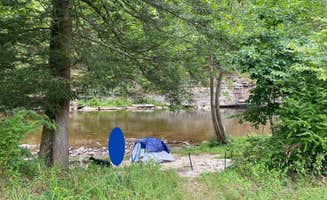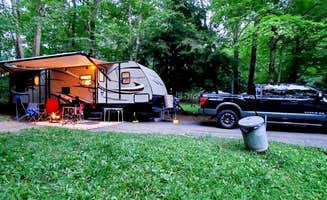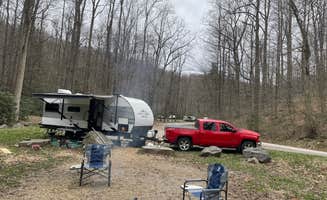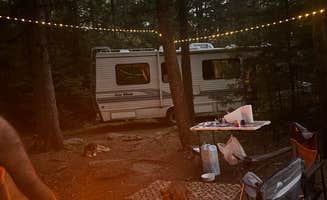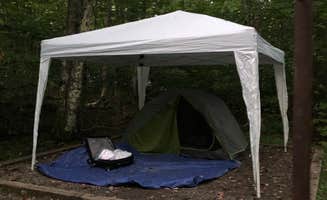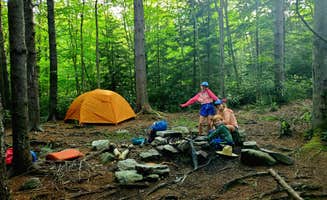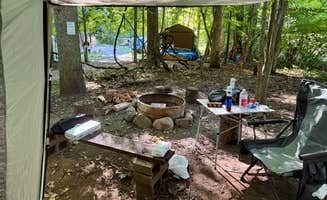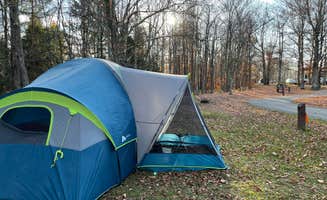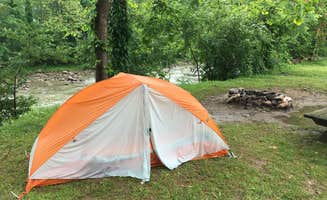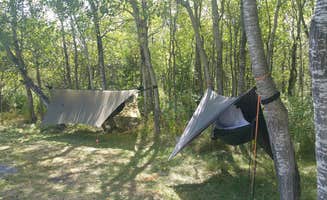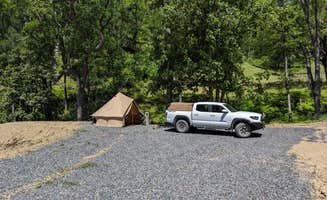The Dryfork area of West Virginia sits at elevations between 2,500-4,000 feet in the Allegheny Mountains, creating distinct microclimates that affect camping conditions throughout the year. Temperatures can drop 15-20 degrees below surrounding valleys, especially at higher elevation camping areas. Forest Service roads accessing dispersed sites often require high-clearance vehicles after heavy rainfall.
What to do
Fishing opportunities: Visit Gandy Creek Dispersed Camping for trout fishing in cool mountain streams. Sites are positioned along the creek with good access points. "The view and sunsets over the river made for gorgeous pictures. We also spent a little time fishing," notes one visitor who stayed at nearby Five River Campground.
Waterfall exploration: Plan a day trip from your campsite to numerous cascades. Several falls are accessible via short hikes. "We did a little climbing & bouldering over the weekend," shares a camper who stayed at Seneca Shadows, adding that they "definitely want to go back!"
Dark sky stargazing: Take advantage of minimal light pollution at higher elevations. The remote nature of many campsites creates excellent viewing conditions. "With no ambient light, the night skies are amazing," reports a visitor to Red Creek Campground, who also mentioned lying "in an open field to stargaze one evening to enjoy a wonderful light show from shooting stars."
What campers like
Privacy between sites: Many dispersed areas offer good separation from other campers. At Lower Glady Dispersed Campground, a camper reported, "Nice and cool. 4 to 8 other campers. No one next to me. There were a couple of small groups, like two rigs together. Nice and quiet."
Diverse ecosystems: Experience dramatically different environments within short distances. The highlands contain unique plant communities not found elsewhere in the region. A camper at Dolly Sods Backcountry noted, "With the incredibly varied landscapes and diverse vegetation, Dolly Sods truly feels like you are somewhere far north from WV. The ferns and evergreens reminded me of being in Maine."
Wildlife encounters: Campsites throughout the region offer opportunities to observe native animals. "We were so quiet, several deer passed between us within arms reach," reported one Red Creek visitor. Another camper at Canaan Valley Resort State Park Campground mentioned, "Deer meander through the primitive tent sites with their fawns each morning and evening."
What you should know
Weather variability: Prepare for significant temperature swings regardless of season. The highlands experience their own weather patterns with frequent precipitation. "Know that it will likely rain on you in Dolly Sods, so always bring rain gear. Also realize, that with climate and conditions similar to the Canadian Tundra, temperatures and winds vary and fluctuate often, any time of year," advises a camper.
Site accessibility: Research road conditions before traveling to remote sites. Many forest roads deteriorate quickly after storms. A camper at Canaan Loop Road Dispersed noted, "Still snow on the ground and very wet in early April, but great dispersed car camp and walk-in camp sites."
Water availability: Plan accordingly for sites without drinking water. Many dispersed sites require filtering water from streams. "I highly recommend filtering before use even though it does not post that," warns a Red Creek Campground visitor regarding a small spring pipe at the site.
Trail conditions: Pack appropriate footwear for potentially wet, rocky trails. The terrain can be challenging even on maintained paths. "Choose footwear wisely, as the trails are strewn with sharp rocks, various stream and river crossings, shoe-swallowing mud bogs along with the regular ol' dirt trail," recommends an experienced hiker.
Tips for camping with families
Playground access: Choose established campgrounds with recreation facilities for younger children. Some sites offer additional amenities for kids. "There is a little park for the kids," mentioned one visitor to Canaan Valley Resort State Park, adding that "there is a huge field that the kids enjoyed kite flying!"
Stream exploration: Select sites with safe water access for supervised play. Shallow creek areas provide natural entertainment. A camper at Five River Campground reported, "The location is amazingly located right on the Shavers Fork river on a section that was shallow and calm enough for our small children to enjoy it."
Wildlife viewing opportunities: Morning and evening offer best chances to see deer and other animals. Children often enjoy spotting forest creatures. "We figured the river would be a crowded place since the campground was nearly full and it was hot but we were pleasantly surprised that most of the week we were the only family on the river!" noted a Five River Campground visitor.
Tips from RVers
Site layout challenges: Research campground maps before selecting a site. Not all established campgrounds are designed optimally. A camper at Blackwater Falls State Park Campground observed, "Many of the pull thru sites are situated in the wrong direction with the electric hookup on the wrong side."
Campground navigation: Prepare for tight turns in some established areas. Some roads may require careful maneuvering. "This is a very oddly laid out campground... The pull throughs are too close to backin sites, so if you come in to pull through, you may have to ask your neighbor to move his vehicle," warns a Blackwater Falls visitor.
Water access planning: Note limited water supply points at some sites. RV campers often need to plan for water conservation. At Blackwater Falls, a reviewer mentioned "the only water available is the same used for flushing" and at another campground, they noted "water at the bathhouse which is inconvenient. You can't drive close to the bathhouse."


